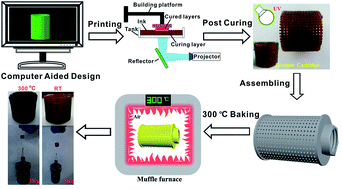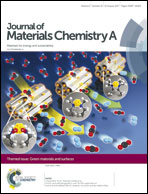Solvent-free and photocurable polyimide inks for 3D printing†
Abstract
High-performance three-dimensional (3D) printing materials are key for the advancement and practical applications of emerging 3D printing technology. However, these are still very few in the market. In this study, photocurable polyimide inks for digital light processing (DLP) 3D printing to produce architectures with excellent comprehensive properties are reported. Maleic anhydride-terminated polyimide oligomers with a glycidyl methacrylate graft were prepared by one-step imidization of phenolic hydroxyl groups containing diamine and aromatic dianhydride in high boiling-point solvent, followed by the reaction of glycidyl methacrylate with the phenolic hydroxyl groups. The good solubility of the oligomers in reactive diluents allowed the formation of a solvent-free photocurable ink for DLP 3D printing, and this ink could be deposited in a layer-by-layer sequence into polyimides with complex shapes. The resultant photocurable polyimide inks were capable of fabricating various complicated, precise architectures with good mechanical and thermoresistant properties. As such, the 3D printing polyimides are believed to be promising in constructing parts and models, such as micro-oil filters, through-tubing materials, cooling valves, and various engine components, where heat resistance, chemical inertness, and high mechanical properties are required.

- This article is part of the themed collection: Green Materials and Surfaces


 Please wait while we load your content...
Please wait while we load your content...